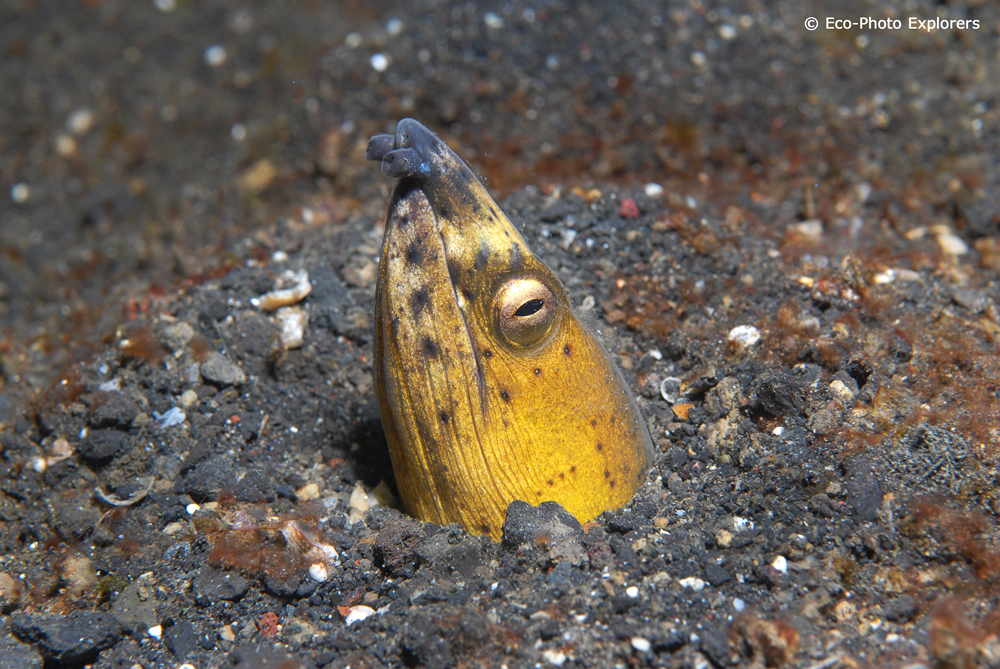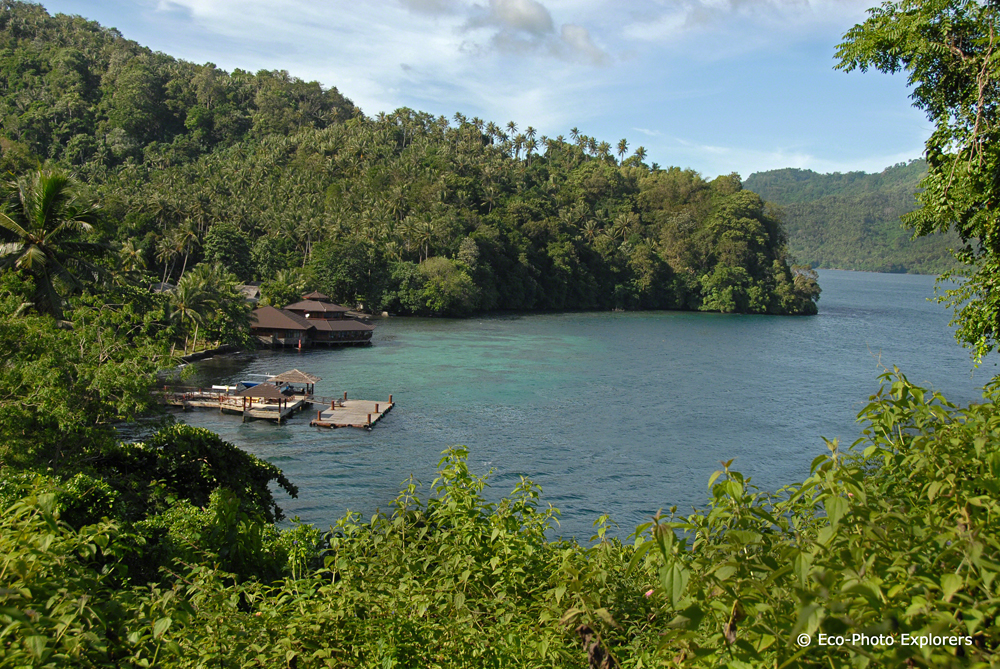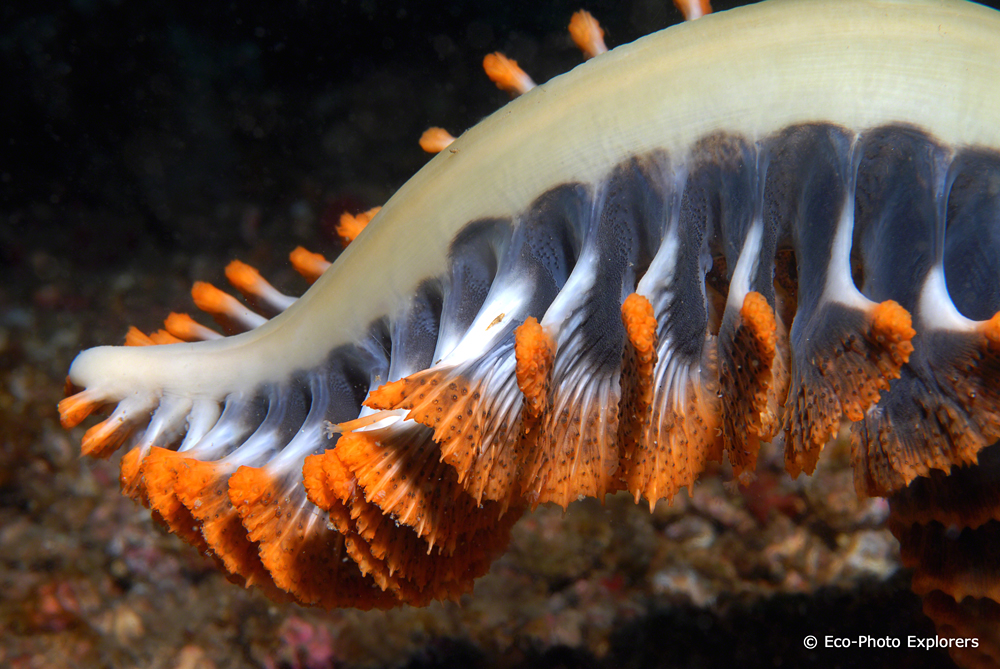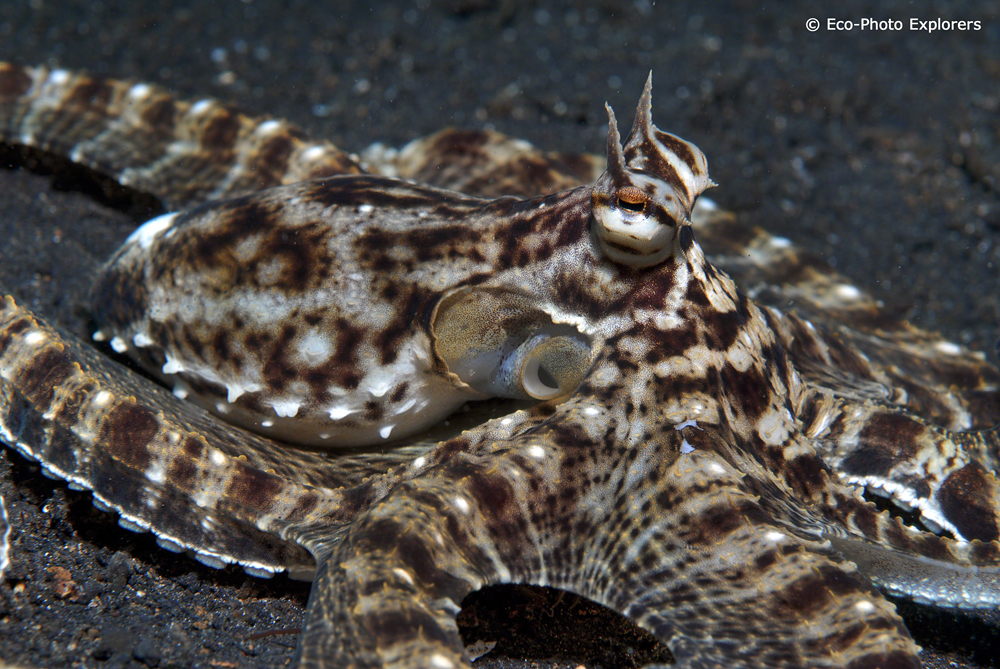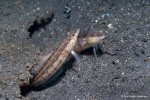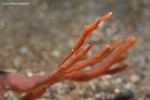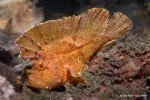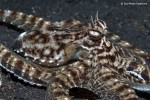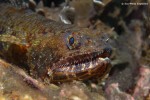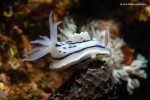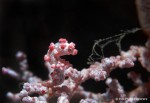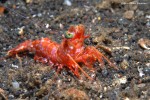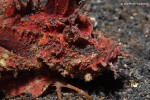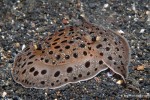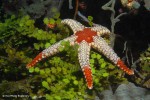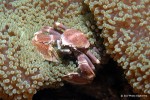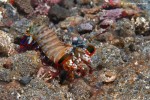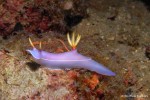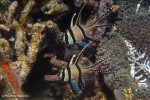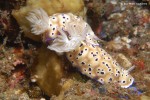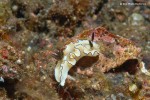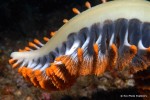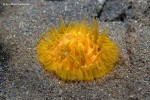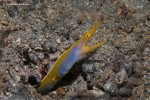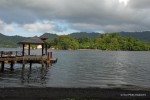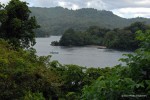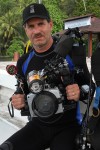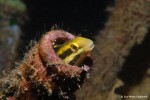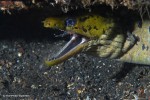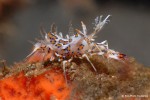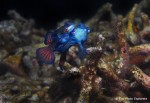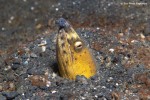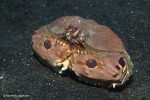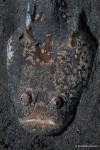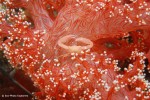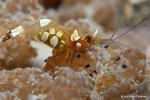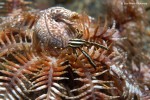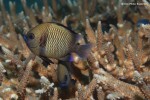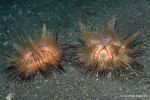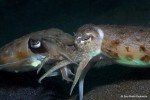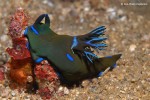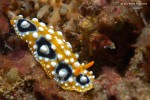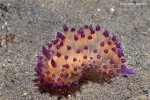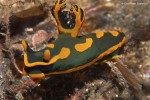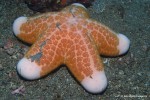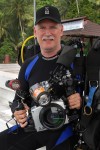The bottom was a grey, featureless expanse of sand and silt, punctuated by occasional islands of debris and detritus. Looking across this apparent desert, our thoughts drifted to the surface of the moon – lifeless, dreary, and mysterious. This is what we travelled halfway around the planet to see?
Suddenly, our eyes spotted something – a pair of eyes poking out of the silt. We approached warily: what monster lurked below? Using a slight wave of our hand, we cleared some of the silt to reveal the horrible creature below. With a fearsome grimace, a Stargazer stared towards the surface, its jagged, toothy frown of a mouth waiting for its next meal to drift by.
Words & Photos by Michael Salvarezza and Christopher P. Weaver
Now, our senses adjusting to this unique type of diving, we began to spot other frightful and amazing creatures: a Devilfish crawling like a demon across the mucky ocean floor, a venomous Stonefish lying in wait alongside a small log, a Pygmy Frogfish resting alongside a Hairy Frogfish – and a Snake Eel, its head poking skyward from the mud.
Slowly, Indonesia’s Lembeh Strait, located in North Sulawesi, began to reveal its secrets – and the reasons why divers travel to this distant location.
Muck diving in Lembeh is unparalleled as a unique dive destination. Here, divers can encounter any number of beautiful and strange creatures – most of them existing on a tiny scale. Macro photography is predominant here as underwater photographers attempt to photograph Pygmy Sea Horses, Dwarf Cuttlefish, Mimic Octopus, and so many varieties of nudibranchs that it is difficult to keep track of them all.
Our base of operations in Lembeh was the renowned Kungkungan Bay Resort & Spa (KBR), which is located so close to some of the most spectacular dive sites that boat rides are often as short as 3-4 minutes! KBR was the original resort in the Lembeh Strait area. They were the first to pioneer muck diving and, though several other resorts and dive operations have been established since, none can equal the standards set by KBR (see below).
Muck diving here consists of descending to 60 feet (18m) or so and searching these otherwise uninteresting stretches for the tiniest of nature’s marvels. The dive guides at KBR are experts at finding these extremely small creatures. You can even dive with Liberty, the local dive guide who discovered a previously undescribed species of Pipe Seahorse.
Indeed, divers at Lembeh tend to turn into amateur biologists, with post-dive conversations escalating into animated discussions conducted while poring over illustrated marine life guides!
Our dives in Lembeh never failed to amaze and inspire, and our eyes quickly became attuned to the tiny world. Before long, we were spotting the tiniest of creatures even without the aid of our guides. Brilliantly colored crabs, fascinating species of shrimp and myriad types of invertebrates occupied our photographic attention constantly.
One special night was spent watching and waiting atop a pile of coral rubble for the shy and elusive Mandarinfish mating dance. We descended to about 10 feet (3m) and waited motionless for well over an hour until, finally, we glimpsed the gaudy fish as they furtively peeked out of their protective crevices. Suddenly, in a flash of color in our dive lights, a pair raced together 1 foot (.3m) above the bottom, mated for 2-3 seconds and disappeared. The dive was over, the image captured and a new memory created forever.
Other dives were spent photographing Mimic Octopus, and their almost identical relation the Wonderpuss. Telling them apart is a challenge – hint: pay attention to the coloring…there’s a subtle difference. In addition, we spotted Porcelain Crabs, Orangutan Crabs, Sea Spiders, Ghost Pipefish, and Flamboyant Cuttlefish. Black, blue and yellow colored Ribbon Eels were frequently encountered as well. In fact, in this one excursion, we were able to check off many of the species that had long been on our own “bucket lists”!
Indonesia’s Lembeh Strait is a small stretch of water between the islands of North Sulawesi and Pulau Lembeh. It is, in fact, a busy waterway and yet it is home to an unbelievable assortment of creatures, many of which are endemic to this area alone and some of which are still undescribed scientifically.
Related stories:
Maldives: Resort Diving in the Rainbow Sea
Ambon, Gateway of the Kings
Diving with Kona Honu Divers: Hawaii’s Famous Manta Ray Dive
As beautiful as the creatures are, the diving here can be challenging. Strong currents are frequent and it is best to heed the advice of the dive guides and dive where there is slack water. And divers who come here expecting ravishing coral reefs will be disappointed. Although there are some colorful outcroppings of coral, the beauty of Lembeh lies in the muck.
For shipwreck enthusiasts, the Mawali wreck offers a terrific diversion. The most commonly dived wreck in the Strait, this Japanese freighter from WWII is lying on its port side and has a length of 90 meters (270 feet). It sits in 90 FSW (30 feet) and makes for an interesting dive for those who are comfortable diving on shipwrecks. Other wrecks in the area include the Bimoli, Indah and Kapal Ikan.
Lembeh deserves protection so that future generations can enjoy this special place and the wonderful collection of weird and beautiful creatures that reside here. The best way to ensure this is for divers to continue to come here. Divers experience, photograph and share stories with others, who will in turn marvel at the plethora of amazing animals to be found here.
At first, it feels like a horror movie with a cheesy title. But soon, it becomes a beautiful symphony of multi-varied macro marine life. It came from the muck…and we couldn’t be happier!
Getting There
The best way to reach Lembeh is via Silk Air into the city of Manado.
A valid passport is required for entry, with enough blank pages for the mandatory tourist visa, which is purchased on arrival, and must be valid for 6 months after arrival.
Immunizations and Medicine
Make sure all your vaccinations are up to date! All travelers should visit their personal physician or a travel health clinic to discuss what vaccinations (Hepatitis A, Hepatitis B, Malaria, Typhoid, and Tetanus-diphtheria) and travel medicine are recommended. All medicine should be packed in their original, clearly labeled containers. Having a signed and dated letter from a physician describing your medical conditions and medications is suggested.
Note: Travel health clinics usually provide more detailed health protection measures since they specialize in travel medicine. Beware of travelers’ diarrhea, which is the most common travel-related ailment. Insect protection is a must and essential!
Baggage
Baggage allowances vary for each international carrier so check before you leave.
Weather
Indonesia has an equatorial tropical climate. October through April is the wet season. May through September is the hottest time of the year, with temperatures in the 80s (27ºC) and 90s (32ºC) Fahrenheit each day. Tropical downpours are common, although severe storms such as pacific typhoons are very rare.
Currency
The local currency is the Rupiah (Rp) but US Dollars are often accepted at all resorts.
Electricity
Power voltage used in Indonesia is 220 Volts (50 Hz). Be sure to double-check your appliance’s compatibility before plugging them in. Converters / adaptors are usually available upon request at your hotel front desk.
Customs
There are a number of different religions that are practiced in Indonesia, Muslim being the most predominate at about 87 percent. Although Christianity is a minority religion in Indonesia, it is not evenly spread throughout the region. It is important to note, Indonesia is a conservative nation and appropriate attire, and cultural sensitivities are important. Check with guidebooks for specific tips on how best to avoid offending the local population.
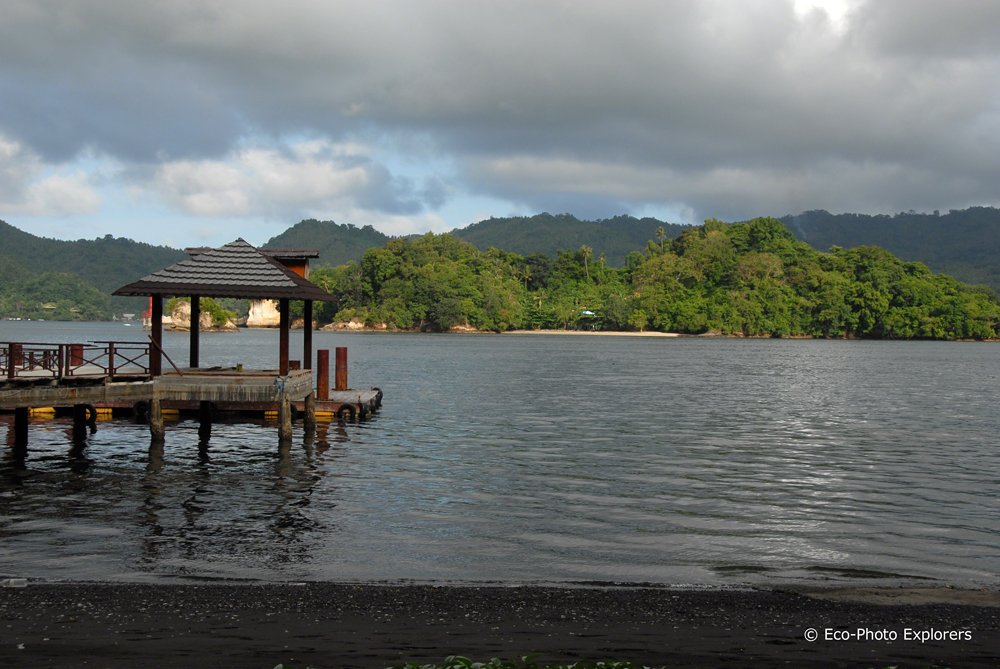
Late afternoon on the Lembeh Strait
Spotlight on Kungkungan Bay Resort & Spa
Location & Getting there:
Kungkungan Bay Resort is nestled on the site of an old coconut plantation on the Sulawesi coast of Lembeh strait. Located on the sunrise side of the peninsula, the view from the guest accommodations encompasses rugged Lembeh Island and the smaller Serena Island. Guests are met at the airport in Manado by resort staff and are driven the 1.5 hours to the resort in air-conditioned comfort.
Facilities:
Facilities at KBR include a private dock with camera rinse tanks and hot showers, camera charging room, air-conditioned bar, swimming pool with swim-up bar, lounge, internet access and lending library. There are also WIFI hot spots available throughout the resort. Restaurant service is available 24-hours of every day. There are also WIFI hot spots available throughout the resort. Restaurant service is available 24-hours of every day.
Accommodations:
KBR has 17 rooms in 4 categories. All the rooms are beachfront (with one exception) and are just steps from the waters of the Lembeh Strait. All of the rooms are air-conditioned with ceiling fans. Standard room amenities include In-Room Telephones, Free Wi-Fi, Stocked Mini-Bar, Coffee/Tea Facilities, Un-Limited Bottled Water, Large Bathrooms w/ Walk-in Showers and Hair-dryer.
Diving Operation:
KBR employs some of the world’s best dive guides, all of whom are well experienced at finding some of the most interesting, unique and difficult to spot marine life in Lembeh Strait. Some of these guides have discovered new species of marine life while diving the waters off KBR.
Since KBR is located in the very heart of the Lembeh Strait, divers have access to fifty dive sites, all within fifteen minutes of the resort.
The dive operation features large dedicated rinse tanks for equipment, with separate tanks for cameras. A fully equipped and secure camera locker features expansive workbenches and charging stations, perfect for serious underwater photographers.
Each day the dive schedule is posted, with multiple small dive boats departing to different dive sites, and dive groups are kept to small numbers for a more intimate experience. Dive briefings are given dockside before the resort staff loads your gear onto the boats. Dives take place through the morning, afternoon and at night. In between dives, the resort staff serves warm tea, refreshing snacks and a delicious lunch.
At KBR, divers can also rent most of the gear they need, and the staff is quite adept and willing to help with equipment repairs to help keep divers diving throughout their stay.
Words & Photos by Michael Salvarezza and Christopher P. Weaver
Photo Gallery – Click any photo to view at full size:
- Small gobies use the muck as a place to live
- Ocellated Tozeuma Shrimp (Tozeuma lanceolatum)
- Leaf Scorpionfish (Taenianotus)
- Mimic Octopus (Thaumoctopus mimicus)
- Fearsome face of a Lizardfish
- There seem to be unlimited numbers of species of Nudibranchs
- Pygmy Seahorse (Hippocampus bargibanti)
- Humpback Prawn (Metapenaeopsis lamellata)
- Spiny Devilfish (Inimicus didactylus)
- Moon-headed Sidegill Slug (Euselenops luniceps)
- Peppermint Sea Star (Fromia monilis)
- Spotted Porcelain Crab (Neopetrolisthes maculates)
- Mantis Shrimp (Odontodactylus scyllarus)
- Bullock’s Hypselodoris (Hypselodoris bullocki)
- A pair of Banggai Cardinalfish (Pterapogon kaudemi)
- Tryon’s Risbecia (Risbecia tryoni)
- Siboga Glossodoris (Glossodoris sibogae)
- Mating Mandarinfish (Synchiropus splendidus)
- Nudibranchs come is a wide variety of shapes, sizes and colors.
- Female Ribbon Eel (Rhinomuraena quaesita)
- Late afternoon on the Lembeh Straight
- North Sulawesi’s Lembeh Straight
- Author Michael Salvarezza
- Home is where you hang your hat
- Fimbriated Moray Eel (Gymnothorax fimbriatus) enjoying the cleaning services of a shrimp
- Spiny Tiger Shrimp (Phyllognathia ceratophthalmus)
- Mating Mandarinfish (Synchiropus splendidus)
- Black-Finned Snake Eel (Ophichthus melanochir)
- Spotted Box Crab (Calappa philargius)
- Whitemargin Stargazer (Uranoscopus sulphueus)
- Soft-coral Porcelain Crab (Lissoprcellana nakasonei)
- Peacock-Tail Anemone Shrimp (Periclimenes brevicarpalis)
- Elegant Crinoid Squat Lobster (Allogalathea elegans)
- Small fish use heathy corals as shelter
- A pair of Radiant Sea Urchins (Astropyga radiata)
- Broadclub Cuttlefish mating (Sepia latimanus)
- Gloomy Tambja (Tambja morose)
- Ocellated Phyllidia (Phyllidia ocellata)
- An undescribed, but beautiful, Arminid Numdibranch
- Gabriela’s Tambja (Tambja gabrielae)
- There are many different species of starfish in Lembeh
- Author Christopher P. Weaver
.

